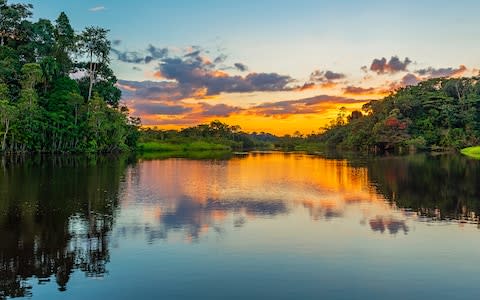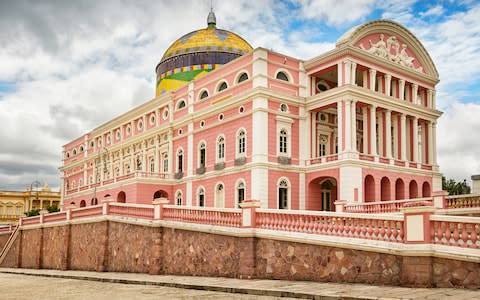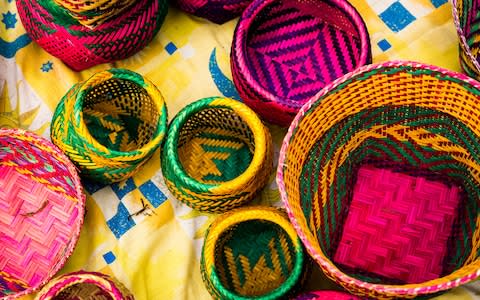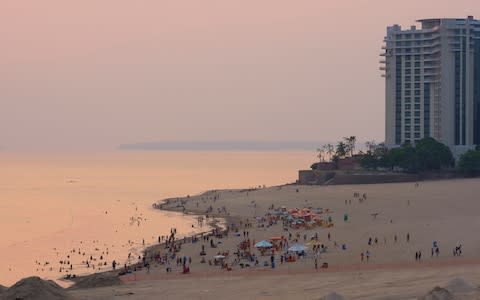The home of Amazonian opera – an expert guide to Manaus, Brazil
![The 'Paris of the Tropics' as Manaus became known in the late 19th Century - @jlbulcao (@jlbulcao (Photographer) - [None]](https://s.yimg.com/ny/api/res/1.2/HCtahMGfBtGjBOIlg9rf0w--/YXBwaWQ9aGlnaGxhbmRlcjt3PTEyNDI7aD03Nzc-/https://media.zenfs.com/en-GB/the_telegraph_258/1948dec2213bf3b8d8b8fe3dbb7f62a4)
Why go?
The Paris of the tropics is a mighty metropolis rising out of the jungle at the point at which the vast Rio Negro pours itself into the muddy waters of the Amazon River. Once the richest city in South America, this is where European culture collides with that of the indigenous peoples of the epic state of Amazonas to create a captivating conurbation that is an essential stop on any Amazon River cruise.
Location
Manaus – free-trade zone and industrial cargo hub for much of the Brazilian Amazon – has well-developed port facilities: Porto Flutuante (floating docks – they rise and fall with the river level) provides docking facilities for everything from speedboats to container ships to gargantuan transcontinental cruis ships. Slap bang in the city centre, the port is the locus of much of the city’s activity.
Can I walk to any places of interest?
Cruis ships pour out of the port into the heart of downtown – a somewhat weather-beaten palimpsest of the past two hundred years of urban development. It is 10 minute’s walk to the opera house – unmissable with its distinctive yellow dome – the area around which is home to some of Brazil’s best-preserved nineteenth-century architecture. The Museu Casa Eduardo Ribeiro, the former home of the first Afro-Brazilian Governor of Amazonas State, is a glorious insight into the lavish lives of the Amazonia upper crust at the turn of the 20th century.
Getting around
Manaus is not small, and you will need wheels to get around. Taxis abound and can be booked by the hour, or by the day.
What to see and do
A trip to Manaus leaves most visitors torn between the opera and the jungle, the river and the beach. Whether its epic jungle adventures, or a shot of Amazonian history and culture you are after, Manaus hosts it all.

What can I do in four hours or less?
Start at the most striking building in the city: Teatro Amazonas, a monumental Renaissance revival opera house dating from the height of the rubber boom at the end of the 19th century when the city was synonymous with stupendous wealth. Gloriously ornate with wrought-iron staircases from England, roofing tiles from Alsace, marble busts from Italy and lavish furnishings from France, the opera house – 9,320m (1,500km) upriver from the coast – rises out of the jungle city like a jewel. There are guided tours daily and regular performances – it is home to the much-respected Amazonas Philharmonic. Time your arrival with the Festival Amazonas de Ópera, which is held each year between April and May.
Manaus is studded with museums, many of which feel empty and unimpressive. Centro Cultural dos Pavos da Amazônia (Cultural Centre of the Peoples of the Amazon) is a somewhat ramshackle cultural complex but at the heart of which sits the superlative Museu do Homen do Norte (Museum of Northern Man). Here the multimedia exhibits and ethnographic artefacts walk visitors through the diverse array of cultures and peoples that call this vast expanse of jungle home.
Once you're done with the city, it’s time to hit the beach. Praia de Ponta Negra is the most popular beach in town, with golden sand sweeping out into the dark waters of the Rio Negro. Here beach volleyballers compete with food stalls while whole families splash about in the water. Those looking for greater seclusion will want to requisition a speedboat and head across the Rio Negro tributary, the Igarapé Tarumã Açu, to reach Praia da Lua, the area’s most idyllic stretch of sand.

What can I do in eight hours or less?
A day is enough to begin to explore some of the natural wonders of this breathtaking region. Start at dawn at the Reserva Florestal Adolpho Ducke, a 39 square mile (100 square kilometre) stretch of jungle on the north-eastern edge of the city – the world’s largest urban forest – named after the legendary botanist and entomologist and one of the most important research sites in the Amazon. Here you’ll find a network of five short trails – closed shoes and guides required – along with MUSA, the Museu da Amazônia, which hosts detailed exhibits on the Amazon flora and fauna and boasts a popular 138ft (42m) high canopy observation deck.
In the afternoon, hop on a boat downstream to the Encontro das Águas, the perennially photogenic meeting of the waters. It is here that the warm black coffee of the Rio Negro hits the milky tea of the Rio Solimões (as the Amazon is called upriver from this point in Brazil). Owing to the differing speed, temperature and density of the rivers, the waters don’t mix for several kilometres making for a remarkable spectacle. To see the waters from the canopy of some of the area’s most impressive trees, take a tour with the excellent Amazon Tree Climbing, who can whisk you away for half a day.
What can I do with a bit longer?
Few come this far without wanting to spend a few nights deep in the forest, visiting indigenous communities and catching sight of the sheer wealth of natural wonders accommodated by a forest the size of Australia. Manaus is a city of scammers, so it pays to research in advance and choose your agency with care. A typical itinerary will include a jungle walk, piranha fishing and nighttime caiman-spotting. River dolphins, monkeys, tarantulas and sloths are all relatively common: manatees, tapirs and jaguars harder to spot. Canoeing through the igarapés – channels navigable only by small craft – raises the chances of wildlife encounter and is a must.
Eat and drink
River fish form the basis of many of the best dishes in Manaus; the prime place to get first sight of the catch is at the fish market just after dawn when hundreds of fishing vessels tie up after, sometimes, weeks on the river. There are reputedly more than 3,000 species of fish swimming around in the Amazon basin, many found nowhere else on Earth. Tambaqui is the most popular and tastiest, and this metre-long giant is ubiquitous in the city’s eateries. Don’t leave without trying tacacá, the traditional herbal shrimp soup.

Don’t leave Manaus without…
Amazonian handicrafts. Manaus is a mecca for traditional wicker wear and textiles. The Adolpho Lisboa Municipal Market has the best selection all under one roof.
Need to know
Flight time
There are no direct flights between London and Manaus. Flights go via Amsterdam or Madrid and either Rio de Janeiro, Sao Paulo or Fortaleza. Expect flight times of at least 18 hours.
Best time to go
Manaus’ long rainy season lasts from November to June when frequent deluges raise the level of the river. March to July, when the igarapés are more easily navigable, is the best time to head into the rainforest. The driest months are June to September, when the humidity drops, but during which time wildlife is harder to spot.

Safety
Like any Brazilian city, Manaus has its fair share of favelas, which are best to avoid. Zona Franca, near the port, is best driven through at night. The city is rife with pickpockets: be vigilant. Book tours through your cruise or in advance.
Opening times
Many Manaus museums close at the weekend.

